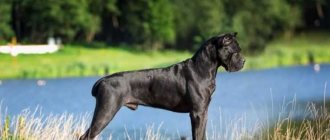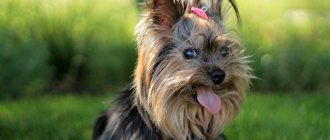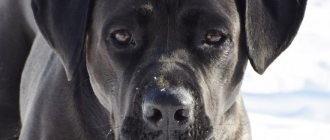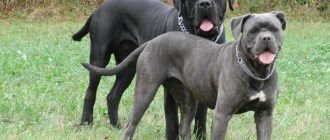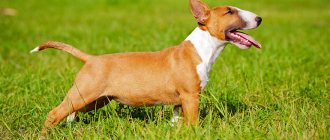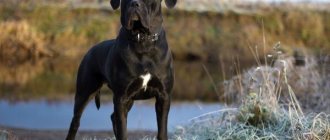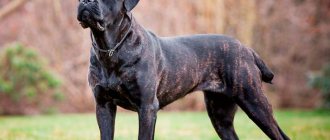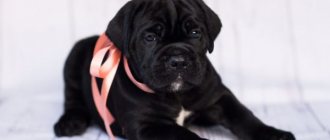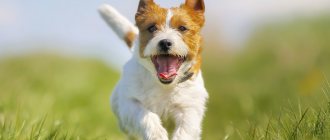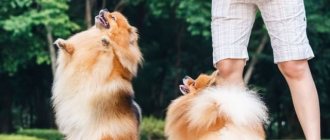Start of training
Training begins when he is taken away from his mother.
Don't wait until the stress passes and the pet gets used to its new home. Rules of behavior will help him quickly get used to new conditions. Strict attitudes from an early age are preferable for an animal than changing attitudes as they grow older. The puppy's contact with the owner develops better if the owner establishes leadership from the first acquaintance. At nine weeks, training begins at home. After the first vaccination, the puppy cannot leave the home. Before going for a walk, he is taught to go to the toilet using a specially placed diaper. It is necessary to train a dog to relieve itself in a certain place to protect it from damage to the floor and things in the apartment. The leash, collar and muzzle are mastered in advance so that the baby is not afraid of them when he has to go for a walk. He is taught to play only with toys. The owner's belongings, shoes and objects are prohibited, as is barking without permission and climbing on the bed.
Dog experts do not recommend scolding a small Cane Corso during classes. Praise is more effective at this age. Because of punishment, the dog grows up embittered, aggressive or angry. Exploration of the place of residence and surrounding objects is not stopped until the pet violates the rules established by man.
Take the Attention Test! Find 10 differences! (click right here!)
Find the answer Are you bothered by some problem or question? Enter “Breed” or “Name of the problem” into the form, press Enter and you will find out everything about the issue that interests you.
Is this breed trainable?
The Cane Corso is not only trainable, this dog literally needs it. It has impressive dimensions and a serious character; You can’t do without proper education. During selection, the dog received many important reflexes; without correction, they can lead to behavioral disorders. Luckily, this breed is quite easy to train. Dogs perceive mental and physical tasks with interest and easily learn new skills.
The importance of training a Cane Corso lies in the fact that dogs can develop fears and aggressive impulses. But interaction with a person and the formation of stable skills will suppress all the wrong instincts of the pet. This will help him socialize and have proper contact with people and animals.
Owners are often left with the question: when to start working with a dog. Raising and training a Cane Corso puppy begins at the age of three months; before this it simply does not make sense: the puppy simply perceives what is happening as a game. However, before you start training, you need to study the rules developed by dog handlers.
Outdoor training
At three months, the dog leaves the apartment and gets acquainted with the world outside the home. Walks are short, in the yard, so that the baby does not get tired. She goes to the toilet wearing a diaper, but she is praised for relieving herself on the street, encouraging her to learn to relieve herself in the right place. Attention is paid to communication with animals and people. A pet should not approach strangers without permission. It is important that taking treats from people is prohibited, as is lifting them from the ground.
By the age of six months, the puppy has the necessary minimum skills:
- Knows the nickname.
- Capable of following with a person without instructions.
- Returns when called.
- Stops at prohibitory signals.
- Silences on command.
- Reacts to “sit”, “lie down”, “paw”, “fu”.
As the pet grows up, it looks for a leader, and the owner must take his role. If authority is not established, it is worth visiting a dog handler and receiving training from professionals.
Training and education of the Cane Corso
Cane Corso are large, strong dogs that are loved for their poise, loyalty and high trainability. When purchasing a puppy of this breed, you need to understand that you will have to devote a lot of time to raising and training the puppy. The peculiarity of this breed is that the psyche is formed late (approximately by 2-3 years), so it is better to start training the puppy from about six months old, and before that you need to start raising it.
Character of the Cane Corso breed
Cane Corso have well-developed security qualities, so they are often bred to guard an apartment, or better yet a country house, because they need freedom of movement and protection of family members. These dogs get along well with their owners, are reserved and obedient, and are incredibly loyal to all family members. They are completely unobtrusive, they will not whine, get bored and do dirty tricks to attract the attention of the owner, but you still need to devote enough time to them and walk them regularly, otherwise the dog will begin to feel sad, and may even get sick, since it will not have the opportunity to spend the energy it has accumulated .
These dogs treat strangers quite calmly, unless the person himself shows aggression towards them or towards the owner. They do not get along very well with other animals and dogs of other breeds, but, most often, only because other animals are simply afraid of them and because of this they show aggression. If there is no aggression from the other animal, the Cane Corso will simply ignore it.
Dogs of the Cane Corso breed treat children with care, they will never touch even other people’s children, and a child from “their own family” will always be protected and looked after. If the child bothers them too much, they will hide or tolerate it. She can become a real nanny for a child - she will protect the baby’s sleep and can even calm a crying child.
Raising a Cane Corso puppy
Education should begin with explaining to the puppy who is the boss in the family. You must become a leader for him. Any aggression towards the owner must be stopped immediately. You should never hit a puppy with your hand; it is better to do it with a rolled up newspaper. There is no need to turn a blind eye to the puppy’s misdeeds, otherwise it will be more difficult to re-educate the dog in the future. It is necessary to teach the puppy to calmly accept various manipulations over him: cutting his fur and claws, washing, treating his eyes, ears and teeth. It is important that during the training period there are many people around the puppy whom he will sniff and study. This is necessary so that in the future the dog will not be aggressive towards people, but, at the same time, will not be afraid of them.
In addition, it is important to teach the puppy to respond to its name, walk on a leash, wear a muzzle, and be toilet trained. To accustom your puppy to your name, you need to call him to the bowl using your name. Later you need to call the puppy to you, calling his name. When the puppy approaches, treat him with some treat. You cannot call your puppy by name to punish him, otherwise he will stop responding to his name! It is important to teach your puppy to walk calmly on a leash while he is not yet so physically strong. Restrain your puppy when he tries to pull on the leash and do not run after him. Also, don't let him chew on the leash or play with it. You can't hit your dog with a leash! Gradually, he will learn to react more calmly to the leash and collar, because he will associate them with a walk.
To get used to a muzzle, you first need to let the puppy “get to know it”, but not allow it to chew or play. For several days, you need to put a treat in the muzzle and let the puppy eat it. Then, during the “acquaintance”, put the muzzle on completely and again give the puppy a treat, and as soon as he eats it, remove the muzzle. It is important to put on a muzzle before you start dressing for a walk. At first, when going outside, immediately remove the muzzle. Next, gradually increase the time spent in the muzzle. You need to walk your puppy at least 3-4 times, but preferably 5-6 times a day. If you take your puppy out every 3 hours, he will gradually get used to doing his business outside.
To prevent your puppy from chewing things when he starts teething, buy him a sufficient number of toys. It is desirable that they be different - rubber, wood, rag, plastic. If the puppy tries to chew your things, you need to stop him by shouting “Ugh!” or “You can’t!”, and if that doesn’t help, slap him with a newspaper. You also need to praise the puppy when he chews his toys.
Don't let your dog jump on you and your guests and put their paws on you! It is necessary to punish the puppy if it shows aggression towards the child, but it is also necessary to explain to the child that the puppy is not a toy and should not be hurt, squeezed or teased.
Training a Cane Corso puppy
It is important to know that during puppyhood, excessive physical activity is contraindicated for your pet, since the Cane Corso grows and develops slowly. Therefore, do not let your puppy run for a long time with adult dogs or go down the stairs - take care of his heart, joints, and ligaments.
Due to their naturally high level of intelligence, dogs of this breed are easy to train and also understand comments well.
At home, training involves teaching the puppy basic commands (“Place”, “Come to me”, “No”, “Sit”, “Lie down”, etc.). A big advantage of home training is the absence of various irritating factors (strangers, animals), and the dog will quickly learn the necessary commands. For the Cane Corso, the best training method is the “carrot and stick” tactic: a sharp tug on the leash and praise in the form of a treat. You need to exercise your dog twice a day.
If rewards are used for training, then training should be done on an empty stomach, but no more than 30-40 minutes. It should be remembered that all commands are given in a clear and confident voice. In addition, commands are pronounced in one word; it cannot be replaced with something similar. Under no circumstances should you yell at or hit your puppy during training!
Remember that the Cane Corso is a very serious breed, and if you have problems at any stage of education or training, do not let the problem take its course, but be sure to consult a dog trainer!
Owner experience
Do not train your baby if you are in a bad mood, dogs are excellent psychologists, and your depression can rub off on them. Both puppies and adults copy their owner in everything; a loving dog will try to be with you.
Dogs are able to find a special approach to everyone in order to satisfy their whims. There are no two identical puppies or adult pets; each has a different character and habits.
His character in the future depends on training. It depends on you whether your pet will grow up to be a cheerful and devoted friend or a nervous, unsociable creature.
Dog instincts in training
Anyone who gets a puppy should remember that its upbringing should be based on innate instincts, which are corrected during the training process and turn into the pet’s character traits.
Thus, the basis of education is social instinct - the relationship between a dog and a person in their pair. The dog strives to communicate, and the pet’s further training and tendency to learn depends on the person’s reaction to this.
When raised, a Cane Corso will react negatively to the owner's attempts to hit or scold her. Therefore, it is necessary to provide negative and positive social markers and stick to them, letting the pet know that his behavior is satisfactory or, on the contrary, undesirable.
An example would be the manifestation of the prey instinct - a dog’s attempt to rush at the owner or bite clothes. All this means that the dog wants to be closer to the owner, and you cannot scold him for this.
But it is still possible and even necessary to correct behavior: to do this, you need to enter a “no” marker and use it every time the dog exhibits unwanted behavior.
After this, the pet needs to demonstrate acceptable behavior that will allow her to satisfy the same instinct - for example, playing tug with a toy - and mark it with a “yes” marker, showing her approval.
The Cane Corso's instincts should also be developed during walks - do not let the dog off the leash to spend free time, but exercise and play with it.
In such cases, the pet itself will demonstrate its upbringing, and in the future it will stop running away during walks, dragging its owner along on a leash, and getting into fights with other dogs.
Why train
Training a dog at home has 3 goals:
- The pet must recognize the owner as a leader.
- The person will know well how to behave with the pet.
- A trained dog is a socially adapted pet.
The owner must choose whether to use deterrents or rewards for a motivational item.
The greatest impact is achieved when the dog receives praise right away.
Containment methods:
- Using objects that can attract the dog's attention. Things that make sharp sounds - whistles, a bunch of keys, a rattle from a tin can with pebbles, etc.
- If the actions are not followed, the dog loses the owner's attention. She is sent to her place without the usual stroking and praise, in a stern voice.
Pet restraint methods can be used on older puppies older than 4 months. If the dog is unbalanced, then this method should not be used.
Ignoring a pet is a more effective technique than physical influence.
Training is quite a labor-intensive task, but teaching a dog to behave correctly is easier than correcting inappropriate behavior.
Training and teaching commands
Training Cane Corso dogs at home has a number of advantages. The animal is focused on following the owner’s commands, feels calmer and more confident, since there are no irritating factors. An individual approach allows you to take into account the characteristics of the dog’s character and behavior.
If you decide to train your pet yourself, get ready to resist the manipulations of the four-legged one, who will try in every possible way to distract you from training. If you have difficulties raising and training your dog, you can use the services of a professional dog handler.
Don't know where to start training Cane Corso? The peculiarities of training representatives of this breed are the stimulation of the animal’s conditioned reflexes. We are talking about the desire for encouragement and the desire to avoid punishment for disobedience.
The first commands that should be taught to a Cane Corso puppy include: “Place!”, “Sit!”, “Lie down!”, “Stand!”, “Come to me!” and “Nearby!”
Thanks to these basic commands, the owner will be able to control the behavior of his pet. To achieve success, it is recommended to use the praise-incentive method. Do not forget about conciseness, consistency and the correct manner of pronouncing commands. The so-called training voice does not imply softness and weakness. Otherwise, it will be difficult for the animal to understand what exactly the owner requires of him.
For a novice trainer
To prevent training from turning into torture:
- Take your pet for a walk beforehand. A tired, running dog is less distracted. The effect will be greater. Active walking makes working with the animal easier.
- The command is spoken once.
- Take pauses. When practicing, for example, “near”, “lie down”, “fetch”, you need to give the dog time to take a breath. 5-10 seconds will be enough.
- Change the sequence. If the dog gets used to doing everything in order. That, for example, after “to me” you need to “sit.”
- You can't overload it. Too intense training can harm the animal.
An already trained dog follows commands under any conditions. But your pet may get tired.
- Sometimes students, like ordinary schoolchildren, “run away from class.” They may be distracted by a nearby cat or other animal. Be more careful with your exposure. Train her on a long leash. This will allow you to catch up with the “mischievous person”, even if he runs fast. A leash with a carabiner for 3-5 meters is suitable. Often such a leash is just needed for endurance and training to pick up “goodies” from the floor.
- “Mass” training is not allowed. Only the owner should act as a trainer. Otherwise the dog will be distracted.
- It's worth pausing. If the animal doubts the correctness of the actions, the reason is the load. Give your dog a simple command and then praise generously. When she sees that the owner approves of him, she will begin to perform the exercises better. Play or take a walk with her.
- Commands are studied systematically and gradually. You need to train your pet to obey in any conditions. Start in a quiet place, gradually adding more “stimulants.” Create them. For example, scatter treats, call a friend to pass by the training place.
To train an animal, you need to be patient and perform the exercises systematically.
Features of the Cane Corso breed
Training course required! You should start raising a puppy immediately after purchasing it. Italians are easy to train, but keep in mind that using physical punishment on them is not recommended. Cane Corso dogs must undergo a general training course and, if necessary, behavioral adjustments. Dogs of this breed are excellent at passing OKD and ZKS due to their endurance and intelligence. Do not forget that the Cane Corso is a serious breed of dog and you take full responsibility for its adequacy and good manners. Cane Corso requires physical and mental exercise, long walking twice a day. If you don’t do this, the dog may chew through all the furniture in the house out of boredom.
General training course
The general training course is based on systematic training. The skills developed during the general course form the basis for the formation of conditioned reflexes in the animal.
The first skill is to teach the puppy to go to the toilet only outside. During the learning process, it is necessary to practice instructions with gestures and voice.
General skills and abilities include:
- Response to nickname;
- Habit of a collar, leash, harness;
- Approach to the trainer;
- Walking nearby;
- Habit of lying, sitting, standing, crawling positions;
- Ability to follow voice commands, stop certain actions, overcome obstacles;
- Refusal of other people's food;
- Tolerance to noise stimuli.
Character and temperament
To fully understand the character and temperament of the four-legged Cane Corso breed, we will have to plunge a little into the history of the origin of these dogs.
The first mentions of this breed are found in ancient Roman chronicles. At that time, large and muscular dogs were used as so-called poisoning gladiator dogs. Probably for this reason, representatives of this breed are often called fighting dogs. However, thanks to their endurance and performance, dogs began to be used in various spheres of life, in particular for guarding livestock and performing guard duty. Today, the Cane Corso dog is chosen as a reliable guard and faithful companion. They respond well to education and training, during the learning process they show calmness and balance, and readily carry out the tasks assigned to them. Training a Cane Corso is a way to suppress excessive aggressiveness, as well as develop social and territorial instincts.
Animals get along well with their owners; out of all family members, one is usually singled out. They are characterized by obedience and restraint. By leaving your pet alone in the house, you can rest assured that the dog will not cause any harm or start misbehaving. Despite the playfulness that is inherent in both Cane Corso puppies and adult dogs, four-legged dogs will not play dirty tricks in order to attract attention to themselves.
Nevertheless, these dogs really love the care of their owner, communication with him, active games and walks in the fresh air. With a lack of attention, the dog begins to mope, as a result of which it may even get sick. This breed is often called aggressive. In fact, they are friendly and reserved dogs that get along well even with children. Cane Corsos can be negative or neutral towards other animals living in the same house as them. In order for the pets to quickly adapt and get used to each other, it is necessary to start raising the Cane Corso as soon as the dog crosses the threshold of your home.
General principles of animal training
To successfully train a pet, systematic training is necessary. The duration of the lesson should not exceed 2 hours. Commands for dogs: the list of techniques practiced in the lesson depends on the level of training of the animal; for example, a Labrador puppy begins to be trained from the first months. Gradually the number of teams should be increased.
New techniques are practiced in the first part of the lesson. After each command, a three-minute break is required for the pet.
Rules for successfully training a puppy:
- Techniques performed correctly should be reinforced with praise and encouragement.
- It is better to voice the instruction once, accompanied by a gesture.
- Maintaining consistency in orders and gestures.
- The first classes are conducted in a familiar environment, then change the environment.
- The trainer and the dog are in a good mood.
- It is better to end the lesson with an instruction that the puppy does better than others.
Basic command training
- “Come to me” is a basic command. You need to start learning it first. The puppy is shown a treat and, calling out its name loudly, an order is pronounced. Over time, “Come to me” will become a reflex, and rewarding with treats will no longer be necessary.
- “Fu” or “No” is a standard prohibiting command. They teach it this way: a piece of treat is placed on the floor, but when the dog shows interest in it, the choke collar is slightly tightened, and the owner expresses his dissatisfaction with his voice. After several weeks of consolidating the command, the noose will not be needed; intonation will be enough.
- To teach “Sit”, you need to show the puppy treats, and then put your hand behind his head. He will involuntarily assume a sitting position. As soon as this happens, you need to praise the dog and give him food. A week of consolidation is enough for the raising of a hand to execute an order.
- The “Lie Down” command is taught in approximately the same way. In order for the puppy to perform the action, you need to press on his shoulder blades. When he lies down, give your pet a rewarding stimulus. A dozen repetitions will be enough to consolidate.
- Initial lessons on the basic command “Give” are carried out in early puppyhood. After pronouncing the order, you need to take away the toy from the puppy that he was fiddling with before. If the pet begins to take it away, you need to show your displeasure. When he calmly gives the item, be sure to give him an edible reward.
Release command
The instruction “Walk” (“Walk” or “Fri”) is a release for dogs that serve in the search and protective guard service.
A professionally working dog, when he is outside the apartment or outside the enclosure, is in a state of “at work”. He rests according to the instructions “Lie down” or “Place”.
If you release your pet with the word “Go for a walk,” then no training is required, the dog will remember it at the same time.
Command your pet to “Sit”, and then release it, joyfully saying “Walk!” If he doesn’t move, then you can, repeating “Walk, walk,” pat her a little, clap your hands, or run forward.
Take breaks every 15-20 minutes.
"Place" indication
Command “Place” and entice him with a treat. On the lounger, praise and give a piece.
Gradually increase the time between arrival and reward, and then give treats occasionally. In everyday life, the “Place” command is used when a pet behaves badly (for example, begging from the table or jumping on guests).
By giving the "Place" command, you tell the dog exactly where he needs to go. They quickly grasp the meaning of this command and leave offended.
If he pesters you, then you need to command “Place” again in a more menacing tone.
Before teaching the “Place” command, make sure that the dog knows the “Lie” and “Come” commands.
Step 1: Place him on a long leash and make him lie down.
Step 2. Place a large item, such as a backpack, next to it. Do not use someone else's things or his things (muzzle, toy or bowl).
Step 3. Repeat the “Down” command to him and move away 5 steps.
Step 4: Wait 3 seconds and then command “Come.” When he approaches you, praise him.
Step 5. Give the “Place” command by pointing your hand at the backpack. Move towards the thing, but don't pull on the leash. As you walk, joyfully repeat: “Place. Place".
Step 6. Once in place, command “Down” and give a treat.
Repeat the exercise. Get him to go to the place without your help. Gradually increase the distance and stop using the leash.
The pet must approach the thing lying 15 meters away, lie down and wait (30 seconds) for you to allow it to leave the position. Teach him to stay still when people or animals walk nearby.
If the dog breaks away without a command, bring it back, repeating: “Place.” If the dog refuses to return to its place without you: call the dog left near the thing, sit it next to you and command “Wait.” Then show the dog the treat and go to the “spot” alone. Place it on your backpack and return to the dog. Command “Place”, and if the dog runs up to the thing and lies down, praise it and let it eat a piece.
Common mistakes when training
- The dog is unconscious of its actions and does not understand human speech. When giving a command, you cannot talk; conditioned reflexes are inhibited. All commands are pronounced without further ado.
- Violations of the order of skill development. From simple to complex. Until the dog has mastered a certain command well, you cannot proceed to the next one.
- The dog handler does not take into account the characteristics of the animal, which reduces the effectiveness of training.
- Retraining. Frequently practicing the same skills helps to fatigue, reduce performance and overload the nervous system. Once the technique is learned, it is no longer performed that day. If she refuses to perform a skill as a result of overtraining, then she is given a rest for 2-3 weeks. Dog handlers monitor the condition of the dog during training.
- Incorrect voice intonation changes the sound of the command. You cannot pronounce everything in one intonation, otherwise it loses its significance as an irritant. The dog will stop responding to her.
- Incorrect use of directions. You can’t repeat it often, otherwise you’ll develop the skill of doing it when you repeat it.
Cors: character and care features
Such a dog can be easily handled by those who have taken it upon themselves to raise their first pet.
She doesn't need to explain who's boss in the house. It adapts to your family hierarchy and has:
- balanced - not subject to sudden outbursts of aggression;
- intelligence - easy to learn, able to concentrate on a lesson, amenable to training and can learn a command literally from the first lesson. Using the skills acquired by puppies, you can then train Canne Corso dogs at any age;
- ability to obey - a trained and trained dog is easy to control, it quickly and correctly carries out commands;
- devotion - adores everyone at home. It’s even amazing how gentle this brave, courageous, distrustful and aggressive dog in case of danger can be towards his “pack”;
- adequacy of behavior - the puppy can be raised with children. He will not harm them, you just need to make sure that the child does not offend him. With proper upbringing, an adult dog will tolerate anything from its small owner. Kors is loyal to pets, takes care of the weak and helpless. From 6-7 months, aggression towards relatives of the same sex can appear. To correct this behavior, group classes under the supervision of professional trainers are recommended.
The dog does not like to be imposed on, it plays and communicates if you want it.
The size of the corse allows it to be kept in urban environments. In a private house, never put him on a chain - this will break his freedom-loving disposition. In winter, the dog must live warm.
Care is simple - active walks for at least 2 hours, with running and games, after walking, wash your paws, clean your ears. Pay attention to your eyes. A feature of the breed is slightly drooping lower eyelids. Take care of them and make sure that no discharge or crusts appear in the corners.
Feed your Corsa according to the schedule suggested by the breeder. If you make up your own diet, include vitamin supplements and give treats to prevent tartar. Attention! There is an allergy to chicken meat.
Health problems are rare for the breed.
